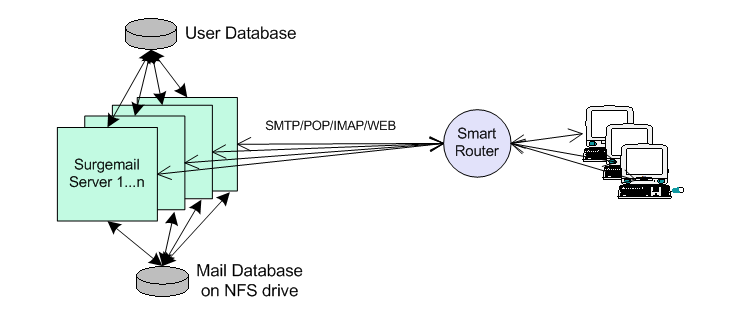Also see the dedicated surgemail.com website with knowledge base and ticketing system
Configuring 'Shared Storage Clusters'
Surgemail can be configured in a more traditional shared storage cluster configuration using an NFS (or other) shared storage device for providing standard mail services.
In this configuration you have several servers all running surgemail handling all mail services storing users mail using the same central storage. The incoming connection load is shared between all servers using an appropriate technique. This is typically a hardware based load balancing router.

| STOP! we think this is the wrong solution for you - here's why |
|---|
|
The normal reason for using this type of cluster are:
All of these reasons are invalid or better done using surgemail's mirroring, here's why:
|
How to configure surgemail to use a shared NFS (or network) drive:
- You should only share the 'mailbox_path' for each domain, do not share the workarea or other directories within surgemail.
- g_share_quota "true"
- g_share_mail "true"
- g_pop_lock "true"
- If you are using a smart router or load balancing tool, read this page
- Do not use of the automatic account expiry and deletion functions such as g_delete_user_after / g_delete_user_mode / g_delete_user_suspend functions.
- To allow webmail to be run on more than one host see this page.
- In the surgemail home directory sym link the directory 'resp' to a shared area (this allows the auto responder to work correctly and each cluster member will remember who has been replied to)
- g_autologin_file "/shared/autologin.dat" - Where that file is shared between all servers via nfs
- In addition you probably should share the directory (suregmail home)/resp (We will provide mechanism to do this on windows shortly)
- g_domuser_file "/shared_folder/domuser.dat" - define the alias file in a shared area so user aliases work
Warnings - Things to avoid doing in this configuration:
- You cannot use surgemail 'mirroring' feature in addition to sharing the mail spool.
- Do not use the migration mechanism on multiple shared hosts at the same time, as then it will be in danger of converting one user twice at the same time.

